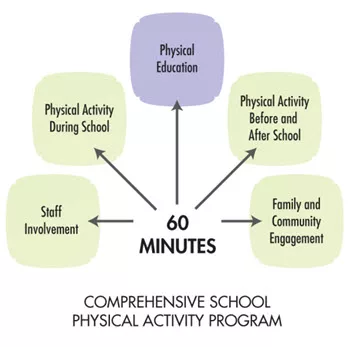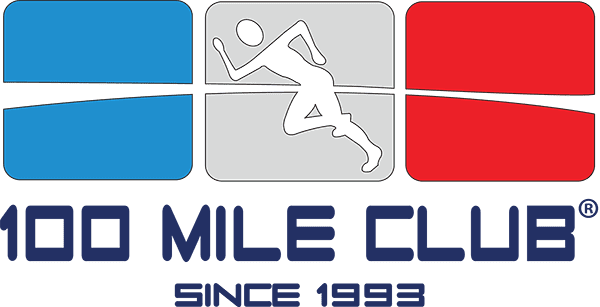Miles of fun delivered to your inbox! Join our Newsletter today!
ESSA, Physical Education, Physical Literacy, CSPAP, and More
Read more below about ESSA, quality physical education, physical literacy, and Comprehensive School Physical Activity Plans below and then dive in to Program Downloads and enjoy our standards-based warmups, games, cool-downs, and team cheers designed especially for our registered schools and coaches. Have fun!
Every Student Succeeds Act (ESSA) and 100 Mile Club
The Every Student Succeeds Act (ESSA) was passed in December 2015 by the US Congress. When describing the essential framework for elementary and secondary education in the United States, ESSA replaced term “core academic subjects” used in No Child Left Behind with the term “well-rounded education”.
ESSA identifies school health and quality physical education as an equal part of a student’s “well-rounded education,” along with academic subjects such as art, music, civics, science and more.
The passage of ESSA was a massive victory for health and physical education!
Quality physical education and health have now been intentionally included in ESSA, putting them on a level playing field with other academic subjects. This was not the case with No Child Left Behind. In fact, it was quite the opposite. Physical education and health were not included at all in NCLB.
Besides recognizing quality health and physical education as an EQUAL part of a “well-rounded education”, this new federal education legislation provides increased access to funds for health and PE programs (including professional development) and allows states and school districts to set their own priorities for funding and accountability. (SHAPE America, 2018)
A lot!!
Physical activity programs, like 100 Mile Club®, have access to significant funding under Title IV of ESSA.
This funding is available in the form of grants and financial allocations awarded to individual states. States will then allocate funds to school districts. Funding is authorized under three broad areas:
- Providing students with a well-rounded education
- Supporting safe and healthy students
- Supporting the effective use of technology
School districts and schools may inquire to their state Department of Education and apply for funding for a wide range of health and physical activity programs (like 100 Mile Club®!).
Visit this link and fill out information to receive an estimate of the amount of funding your state will receive this school year.
Advocate and make your voice heard.
It’s critical that educators, parents, and community champions advocate for quality physical education and physical activity programs to principals, superintendents, title coordinators, curriculum directors, and other key stakeholders such as PTA, school boards, and community leaders.
We encourage you to get involved in the development of your school and district ESSA implementation plans, applications for ESSA funds, and development of your school and district Comprehensive School Physical Activity Program (CSPAP).
Quality Physical Education
The goal of quality physical education is to develop physically literate individuals who value and have the confidence, knowledge, and skills necessary to enjoy a lifetime of exercise and healthy physical activity.
A physically literate individual:
- Has learned the skills necessary to participate in a variety of physical activities.
- Knows the implications and the benefits of involvement in various types of physical activities.
- Participates regularly in physical activity.
- Is physically fit.
- Values physical activity and its contributions to a healthful lifestyle (SHAPE, 2014, p.1)
It is important to clarify the common technical terms used in physical education; the terms physical activity, exercise, and physical education define three very different aspects of physical literacy.
Physical Activity: any bodily movement that results in energy expenditure.
Exercise: any physical activity that is planned, structured and repetitive for the purpose of improving or maintaining one or more components of fitness.
Physical Education: an academic subject that provides a planned, sequential, K‐12 standards‐based program of curricula and instruction designed to develop motor skills, knowledge and behaviors for healthy, active living, physical fitness, sportsmanship, self‐efficacy and emotional intelligence.
A well-designed physical education program:
- Meets the needs of all students;
- Keeps students active for most of physical education class time;
- Teaches self-management;
- Emphasizes knowledge and skills for a lifetime of physical activity; and
- Is an enjoyable experience for all students (CDC, 2013, p. 12).
CSPAP, Standards, and 100 Mile Club
A Comprehensive School Physical Activity Program (CSPAP) is a multi-component approach by which school districts and schools use all opportunities for students to be physically active, meet the nationally-recommended 60 minutes of physical activity each day, and develop the knowledge, skills, and confidence to be physically active for a lifetime. A CSPAP reflects strong coordination and synergy across all of the components: quality physical education as the foundation, physical activity before, during, and after school, staff involvement, and family and community engagement. (CDC, 2015)
CDC, in collaboration with SHAPE America, developed a step-by-step guide[PDF – 6MB] for schools and school districts to develop, implement, and evaluate comprehensive school physical activity programs.

SHAPE America’s National Standards & Grade-Level Outcomes for K-12 Physical Education define what a student should know and be able to do as result of a highly-effective physical education program. States and local school districts nationwide use the National Standards to develop, evaluate and/or revise existing state standards, frameworks and curricula.
100 Mile Club® will reference national standards and corresponding grade-level outcomes when appropriate in shared lessons, games, and activities.
Standard 1: The physically literate individual demonstrates competency in a variety of motor skills and movement patterns.
Standard 2: The physically literate individual applies knowledge of concepts, principles, strategies and tactics related to movement and performance.
Standard 3: The physically literate individual demonstrates the knowledge and skills to achieve and maintain a health-enhancing level of physical activity and fitness.
Standard 4: The physically literate individual exhibits responsible personal and social behavior that respects self and others.
Standard 5: The physically literate individual recognizes the value of physical activity for health, enjoyment, challenge, self-expression and/or social interaction.
The 100 Mile Club® is a free, simple, enjoyable, standards and evidence-based, and highly effective way to assist in the development of physically literate individuals, quality physical education programs, and can serve as a significant part of a Comprehensive School Physical Activity Program (CSPAP), addressing needs in all component areas.
Talk to your school about 100 Mile Club®, why it is important, and how it
- contributes to quality physical education and physically literate students,
- supports ESSA,
- and is a significant contributor to the effective development and implementation of your schools Comprehensive School Physical Activity Program (CSPAP).
Healthy Schools Overview (CDC) Guidelines and resources.
Every Student Succeeds Act (ESSA)
Comprehensive School Physical Activity Programs: A CSPAP guide for Schools. Developed by CDC and SHAPE America
Training Tools for Healthy Schools. Visual overview of CSPAP
Centers for Disease Control and Prevention. (2013). Comprehensive school physical activity programs: A guide for schools. Atlanta, GA: U.S. Department of Health and Human Services.
Centers for Disease Control and Prevention. (2014). National framework for physical activity and physical education. Atlanta, GA: U.S. Department of Health and Human Services.
Center for Disease Control. (2015). Comprehensive School Physical Activity Program (CSPAP). https://archive.cdc.gov/#/details?url=https://www.cdc.gov/healthyschools/physicalactivity/cspap.htm
SHAPE America. (2013). Grade level outcomes for K-12 Physical Education. https://www.shapeamerica.org/standards/pe/upload/Grade-Level-Outcomes-for-K-12-Physical-Education.pdf
SHAPE America. (2014). National standards & grade-level outcomes for K-12 physical education. Champaign, IL: Human Kinetics.
SHAPE America. (2015). The essential components of physical education. Retrieved from https://www.shapeamerica.org/uploads/pdfs/TheEssentialComponentsOfPhysicalEducation.pdf
